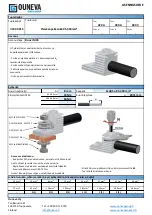
7
WARNING
!
ReliaGuard Warnings and Configurations
•
Read and follow ALL
safety, use, sizing, installation, and care instructions
and follow all building codes, construction standards, appliance manufac-
turer recommendations and instructions, and applicable ANSI standards .
• Gas connector installation and testing procedures
MUST BE
performed by
a licensed contractor .
• Installation of the ReliaGuard gas connector
MUST BE
in compliance with
the National Fuel Gas Code (ANSI Z223 .1/NFPA 54), Natural Gas and
Propane Installation Code (B149 .1), or the International Fuel Gas Code
(IFGC), in addition to all federal, state, and local gas installation codes .
• A restraining device
MUST BE
connected when a moveable gas appliance
is in service, as required by fuel gas codes and ANSI/CSA product
standards .
• If a gas odor or leak is detected or suspected before, during, or after
installation,
IMMEDIATELY
turn off the gas supply and have gas lines, gas
connector, fittings, and appliance inspected by professionals .
•
DO NOT REUSE.
This gas connector and its accessories are intended
for a single installation and should be used on the original appliance at the
original location only . If the appliance is replaced or moved to a location
other than the original kitchen footprint, you
MUST
replace the gas con-
nector and its accessories .
•
DO NOT
over-extend the gas connector assembly as this can cause dam-
age to the gas connector and/or shorten the life of the connector . Follow all
instructions on the proper movement of the appliance for cleaning, mainte-
nance, or service .
•
DO NOT
use the gas connector or its accessories if they are damaged in
any way . Discard any damaged items and replace with new items .
•
DO NOT
run a gas connector through walls, partitions or floors . The gas
connector must always be visible and accessible and should never be
concealed .
•
DO NOT
install a gas connector in an area where it can come into contact
with wiring, sharp edges, or surfaces that reach temperatures in excess of
230°F (110°C) .
•
STRONG CLEANING SOLUTIONS OR CHEMICAL SUBSTANCES
SHOULD NOT COME IN CONTACT WITH THE GAS CONNECTOR
OR ACCESSORIES.
These may include acids, solvents, fluxes with zinc
chloride, or other chlorinated chemicals . If contact occurs, rinse the gas
connector and/or accessories with water and dry thoroughly with clean
cloths . If there are any signs of damage to the gas connector or accesso-
ries, turn off the gas supply and have the gas line replaced by a profession-
al immediately .
• The final assembly
MUST BE
tested for leaks .
NEVER
use an open flame
or other sources of ignition for leak testing purposes and be aware that
some leak test solutions may cause corrosion .
RINSE THE INSTALLED
ASSEMBLY WITH WATER AFTER HAVING THE LEAK TEST
PERFORMED.
To check the gas supply piping system for leakage, see
National Fuel Gas Code (ANSI Z223 .1/NFPA 54), Natural Gas and Propane
Installation Code (B149 .1), or the International Fuel Gas Code (IFGC) . If an
odor of gas is detected or suspected, turn off the gas to the appliance and
have a licensed contractor identify the leak source and eliminate it .
•
DO NOT
use the gas connector as an appliance ground . Appliance must
be independently and properly grounded .
•
NEVER
jump, stand or otherwise place weight on the gas connector,
regardless of whether it is connected or disconnected .
To avoid injury, death, fire, explosion, gas leak, or property damage:








































